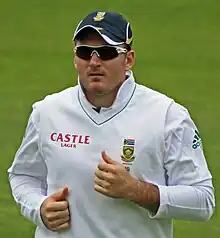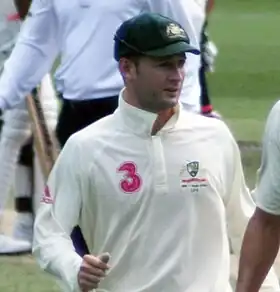Captain (cricket)
The captain of a cricket team, often referred to as the skipper,[3] is the appointed leader, having several additional roles and responsibilities over and above those of the other players. As in other sports, the captain is usually experienced and has good communication skills, and is likely to be one of the most regular members of the team, as the captain is responsible for the team selection. Before the game the captains toss for innings. During the match the captain decides the team's batting order, who will bowl each over, and where each fielder will be positioned. While the captain has the final say, decisions are often collaborative. A captain's knowledge of the complexities of cricket strategy and tactics, and shrewdness in the field, may contribute significantly to the team's success.


Due to the smaller coaching/management role played out by support staff, as well as the need for greater on-field decision-making, the captain of a cricket team typically shoulders more responsibility for results than team captains in other sports.[4]
Captain's responsibilities
The toss
Starting from team selection and then toss Before the start of a match the home captain tosses a coin and the away captain calls heads or tails. The captain who wins the toss is given the choice of whether to bat or bowl first.[4] The decision usually depends on the condition of the pitch and whether it is likely to deteriorate, the weather conditions and the weather forecast.
The decision also depends on the relative strengths of the team's batting and bowling. For instance in Test cricket, a side with only fast bowlers may choose to bowl first to try to take advantage of any early moisture in the pitch, knowing that it will be harder to take wickets later in the match. Similarly a side with a weak opening batting pair may choose to bowl first in order to protect their batsmen.[5]
Fielding positions
The captain decides where the fielders will stand, in consultation with the bowler and sometimes other senior players. The fielding positions will usually be dictated by the type of bowler, the batsman's batting style, and the captain's assessment of the state of the match (and hence whether to set an attacking or a defensive field).[4]
Bowling
The captain decides when each bowler will bowl. If a batsman is seeking to dominate the current bowler, the captain may ask someone else to bowl; alternatively, keeping the bowler on may be deemed the best chance of getting the batsman out or restricting the scoring rate. If the regular bowlers are not achieving the desired results, the captain may decide to use non-regular bowlers to attempt to unsettle the batsmen. The captain may also change the bowlers around to introduce variation, and to prevent the batsmen getting "set".[4]
In limited overs cricket the captain additionally has to make certain that bowlers bowl no more than their allotted maximum number of overs, and that experienced bowlers are available at the end of the batting side's innings, when the batsmen are usually looking to take risks to attack and score quickly.[4]
In the longer forms of cricket, when a new ball becomes available the captain decides whether to use it, and when given that it can be taken any time after it becomes available.[4]
Batting order
When the team bats, the captain decides the batting order. In professional cricket the captain usually changes the established batting order only for exceptional reasons, because batsmen tend to specialise in batting at certain positions. However, in certain circumstances it may be in the team's interest to change the batting order. If quick runs are needed, a naturally attacking batsman may be promoted up the order. A player who is 'in form' may be promoted to a higher batting position, at the expense of a player who is 'out of form'.[4]
If a wicket falls near the end of a day's play, especially if the light is failing, or if the bowlers seem particularly confident, the captain may choose to send in a non-specialist batsman, referred to as a nightwatchman. If the nightwatchman does not get out before the end of that day's play then the specialist batsman will have been protected, and will not need to bat until the following day when conditions are likely to have improved. If the nightwatchman does get out, the cost of losing a late wicket will have been minimised, because the specialist batsman is still available to bat.[4]
Declarations
The captain may declare the team's innings closed at any time, but usually only does so as an attacking ploy, for instance if the captain thinks the team has enough runs to win the match, or if a sudden change in conditions has made it advantageous to bowl rather than bat.[4]
Follow-on
In a two-innings match, if the situation arises the captain decides whether to impose the follow-on.[4]
Miscellaneous
The captain is also consulted on whether an injured batsman from the opposing team may use a runner when batting. Permission is usually given if the batsman has become injured during the course of the match, but if the batsman was carrying the injury at the start of the match then the captain may refuse. (As of 2012, runners are not allowed in Test cricket and injured batsmen are required to continue batting with the injury or retire hurt.)[6]
Other duties
As well as decisions taken either immediately before or during a match, captains also often have some responsibility for the good running of the cricket club. For instance, they may decide when the team is to practise, and for how long. In professional cricket the captain often has some say in who will form the squad from which teams are selected, and may also decide how young up-and-coming players are to be encouraged and improved, and how members of the squad who are not regularly selected for first-team matches are to gain match practice.[4]
Prior to July 2015, the captain was responsible for deciding when to take batting and bowling powerplays in limited overs matches.[7]
Vice-captain

The captain may be assisted by a vice-captain or in some instances joint vice-captains. This is particularly useful if the captain is forced to leave the field of play during fielding. Some teams also allocate the vice-captain a more or less formal role in assisting with team selection, discipline, field-setting and so on. Sometimes the role of vice-captain is seen as preparation for the player(s) becoming the captain of the side in future.[9]
Current men's international captains
ICC Full Members
Associate Members
Current women's international captains
ICC Full Members
| Nation | Format | Captain | Vice-captain |
|---|---|---|---|
| Test | Meg Lanning | Alyssa Healy | |
| ODI | |||
| T20I | |||
| Test | Nigar Sultana | Rumana Ahmed | |
| ODI | |||
| T20I | |||
| Test | Heather Knight | Nat Sciver-Brunt | |
| ODI | |||
| T20I | |||
| Test | Harmanpreet Kaur | Smriti Mandhana | |
| ODI | |||
| T20I | |||
| Test | Laura Delany | Mary Waldron | |
| ODI | |||
| T20I | |||
| Test | Sophie Devine | Amy Satterthwaite | |
| ODI | |||
| T20I | |||
| Test | Bismah Maroof | Javeria Khan | |
| ODI | |||
| T20I | |||
| Test | Suné Luus | Chloe Tryon | |
| ODI | |||
| T20I | |||
| Test | Chamari Athapaththu | Harshitha Madavi | |
| ODI | |||
| T20I | |||
| Test | Hayley Matthews | Shemaine Campbelle | |
| ODI | |||
| T20I | |||
| Test | Mary-Anne Musonda | Josephine Nkomo | |
| ODI | |||
| T20I | |||
Associate Members
| Nation | Captain | Vice-captain |
|---|---|---|
| Laura Mophakedi | ||
| Roberta Moretti Avery | ||
| Jeannette Gonzalez | ||
| Huang Zhuo | ||
| Marie Violleau | ||
| Anuradha Doddaballapur | Christina Gough | |
| Kary Chan | ||
| Nasimeh Rahshetaei | ||
| Rosa Hill | ||
| Queentor Abel | Sharon Juma | |
| Boitumelo Phelenyane | ||
| Mary Mabvuka | ||
| Caroline Owen | ||
| Fatima Guirrugo | ||
| Irene van Zyl | Yasmeen Khan | |
| Rubina Chhetri | Indu Barma | |
| Samantha Agazuma | ||
| Kaia Arua | ||
| Sarah Uwera | ||
| Regina Lili'i | ||
| Linda Bull | ||
| Shafina Mahesh | ||
| Inyeong Oh | ||
| Elspeth Fowler | ||
| Fatuma Kibasu | ||
| Naruemol Chaiwai | Nannapat Koncharoenkai | |
| Rita Musamali | ||
| Chaya Mughal | ||
| Sindhu Sriharsha | ||
| Selina Solman |
See also
- The Art of Captaincy, a 1985 book by former England captain Mike Brearley
References
- "Records / Test matches / Individual records (captains, players, umpires) / Most matches as captain". ESPNcricinfo. Retrieved 18 January 2016.
- "Records / Test matches / Individual records (captains, players, umpires) / Most matches as captain". ESPNcricinfo. Retrieved 22 January 2019.
- ""skipper" Definitions". Wordnik. Retrieved 31 January 2015.
- "The Role of the Captain". DangerMouse. Retrieved 31 January 2015.
- "Numbers Suggest the Toss Has Never Been More Important in Test Cricket". Bleacher Report. 22 February 2014. Retrieved 31 January 2015.
- "Runners abolished, ODI and run-out laws tweaked". ESPN Cricinfo. 27 June 2011. Retrieved 31 January 2015.
- Gollapudi, Nagraj (26 June 2015). "Bowlers benefit from ODI rule changes". ESPNcricinfo. Retrieved 7 February 2015.
- Brettig, Daniel (8 August 2015). "Clarke announces retirement after Ashes". ESPNcricinfo. Retrieved 20 January 2016.
- "Enfield Cricket Club – Captains & Player Responsibilities". Enfield Cricket Club. Archived from the original on 1 February 2015. Retrieved 31 January 2015.
- "Asghar Afghan sacked as Afghanistan opt for split captaincy". espncricinfo.com. 1 June 2021. Retrieved 1 June 2021.
- "Cummins confirmed as Test captain, Smith his deputy". cricket.com.au. Retrieved 26 November 2021.
- "Cummins named Australia's ODI captain". cricket.com.au. Retrieved 18 October 2022.
- "Litton Das to captain Bangladesh in ODIs following Tamim Iqbal's shock retirement". indiatoday.in. Retrieved 10 July 2023.
- "Joe Root steps down as England's Test captain". English Cricket Board. Retrieved 15 April 2022.
- "Ben Stokes appointed as England's new Test captain". skysports.com. Retrieved 28 April 2022.
- "Buttler confirmed as England's new white-ball captain following Eoin Morgan's retirement". Sky Sports. Retrieved 1 July 2022.
- "Rohit named India's ODI and T20I captain as India announce Test squad for SA tour". International Cricket Council. Retrieved 8 December 2021.
- "Rohit announced as India's full-time Test captain". International Cricket Council. Retrieved 19 February 2022.
- "No Virat, Rohit Again! Ajit Agarkar's Selection Committee to Continue with Hardik Pandya as Captain: Report". 5 July 2023.
- "'Still feels like a dream': Suryakumar Yadav on becoming India's new T20I vice-captain". The Times of India. 28 December 2022.
- "Balbirnie appointed Ireland T20I captain". 29 November 2019.
- "Kane Williamson steps down as New Zealand Test captain". espncricinfo. Retrieved 15 December 2022.
- "Babar Azam appointed captain for all three formats and for a long time: PCB chief executive". The Times of India. 30 November 2020. Retrieved 16 May 2023.
- "It 'was unimaginable but dreams do come true', Shadab Khan says after being named Pakistan vice-captain". Batting with Bimal. 19 October 2020. Retrieved 16 May 2023.
- "Shaheen Afridi returns to Test side for Sri Lanka tour". www.pcb.com.pk. 10 January 2014. Retrieved 13 September 2023.
- "South Africa name Dean Elgar Test captain and Temba Bavuma ODI and T20I captain". ESPN Cricinfo. Retrieved 4 March 2021.
- "Bavuma replaces Elgar as Test captain, relinquishes T20 captaincy". ESPN Cricinfo. Retrieved 19 February 2023.
- "Aiden Markram announced as Proteas T20 captain, Bavuma remains ODI captain". Cricket Australia. Retrieved 7 March 2023.
- J, Lin (5 February 2019). "Dimuth Karunaratne appointed as the Stand-In Captain for series against South Africa". The Sunday Reader - Sri Lankan News. Archived from the original on 27 July 2020. Retrieved 22 May 2019.
- "West Indies name ODI and T20 squad for India tour".
- "Zimbabwe name Craig Ervine as limited overs captain; Sean Williams to continue leading in Tests". Cricbuzz. Retrieved 7 March 2022.

